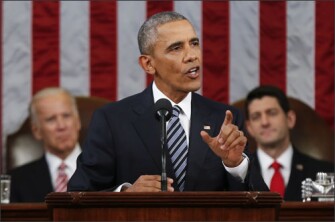
In his final State of the Union address, delivered on Tuesday night, President Obama laid out his hopes for the country’s future. In a spirited defense of his administration, Obama make a case for having confidence in America’s direction.
But ain’t nobody got time for all that. Here’s a quick summary of major points, so that you can pretend you watched.
How long was the address?
A breezy 57 minutes. (Three minutes less than last year! #YesWeCan)
Give me a condensed version.
The State of the Union is strong. The Union is an MMA fighter on three cans of Red Bull and a wheelbarrow of Toradol.
Hit me with some education highlights:
In just under 80 seconds, the president ran through the pre-K-to-college section of the speech, listing successes of the past seven years and goals yet to be accomplished. He later touched on themes of tolerance and unity that any educator could relate to.
My colleague Alyson Klein lives, sleeps, and eats federal education policy, and has a very extensive summary of each piece of the education section. You should read that.
I’m cramming down a Pop-Tart in between classes. Do I look like I have time for nuanced coverage?
OK, here is the K-12 section of the president’s remarks:
We agree that real opportunity requires every American to get the education and training they need to land a good-paying job. The bipartisan reform of No Child Left Behind was an important start, and together, we've increased early childhood education, lifted high school graduation rates to new highs, boosted graduates in fields like engineering. In the coming years, we should build on that progress, by providing pre-K for all and offering every student the hands-on computer science and math classes that make them job-ready on day one. We should recruit and support more great teachers for our kids.
President Obama signed the bipartisan reform of NCLB, the Every Student Succeeds Act, this past December. Here’s a full explanation of the law, which scales back some of the federal role in education.
Some states and districts have made major strides toward universal pre-K, although financial issues and political wrangling have slowed down the movement elsewhere.
Thirty-six states saw increases in graduation rates from the 2012-13 to the 2013-14 school years. Only five states and the District of Columbia saw dips, and eight didn’t see a change.
As for science education, President Obama has been a major advocate for a focus on science, technology, engineering, and math. And according to the American Society for Engineering Education, engineering bachelor’s degrees rose by 6 percent in 2012, and master’s degrees reached an all-time high that same year. Here’s more on the president’s STEM record, from my colleague Liana Heitin.
The president didn’t expand on “recruiting and supporting great teachers,” but that is an acknowledgement that despite the attention paid to teacher recruitment, perhaps the bigger issue is teacher retention.
Hit me with something inspirational.
When politicians insult Muslims, when a mosque is vandalized, or a kid bullied, that doesn't make us safer. That's not telling it like it is. It's just wrong. It diminishes us in the eyes of the world. It makes it harder to achieve our goals. And it betrays who we are as a country.
Another! Another!
Our brand of democracy is hard. But I can promise that a year from now, when I no longer hold this office, I'll be right there with you as a citizen — inspired by those voices of fairness and vision, of grit and good humor and kindness that have helped America travel so far. ... They're out there, those voices. They don't get a lot of attention, nor do they seek it, but they are busy doing the work this country needs doing. ... I see it in the Dreamer who stays up late at night to finish her science project, and the teacher who comes in early, maybe with some extra supplies that she bought, because she knows that that young girl might someday cure a disease.
Any other important moments worth mentioning?
In a touching moment, Obama announced that Vice President Joe Biden would spearhead an initiative to end cancer.
Were any educators among the official White House guests?
The White House invited 23 guests this year. Among them:
- Oscar Vasquez, a Mexican immigrant who, as a high school student, led a team of peers to victory in an underwater robotics competition over some MIT students.
- Braeden Mannering, a 6th grade student who started a nonprofit that provides healthy food to homeless and low-income individuals
- Lydia Doza, a student at Oregon Tech who is working to engage Native American youth in STEM education
The most significant guest, perhaps, was the empty seat next to First Lady Michelle Obama, symbolizing the victims of gun violence in the United States.
Is the president’s record any good on achieving goals mentioned in his State of the Union addresses?
Again via Alyson Klein, here’s a detailed breakdown. In a phrase: Sorta OK.
Where’s the transcript?
Here you go. It’s a comfortable 5,400+ words.
If I had to choose between watching the speech and watching something else ...
How many times have you seen “Star Wars: The Force Awakens?” You could go see that again! The CW’s “Crazy Ex-Girlfriend” is a total delight, too.
Maybe something a little shorter?
Here is a cute GIF.

Image: President Barack Obama delivers his final State of the Union address to a joint session of Congress. Credit: Evan Vucci/AP
Live the glory of past State of the Union speeches: